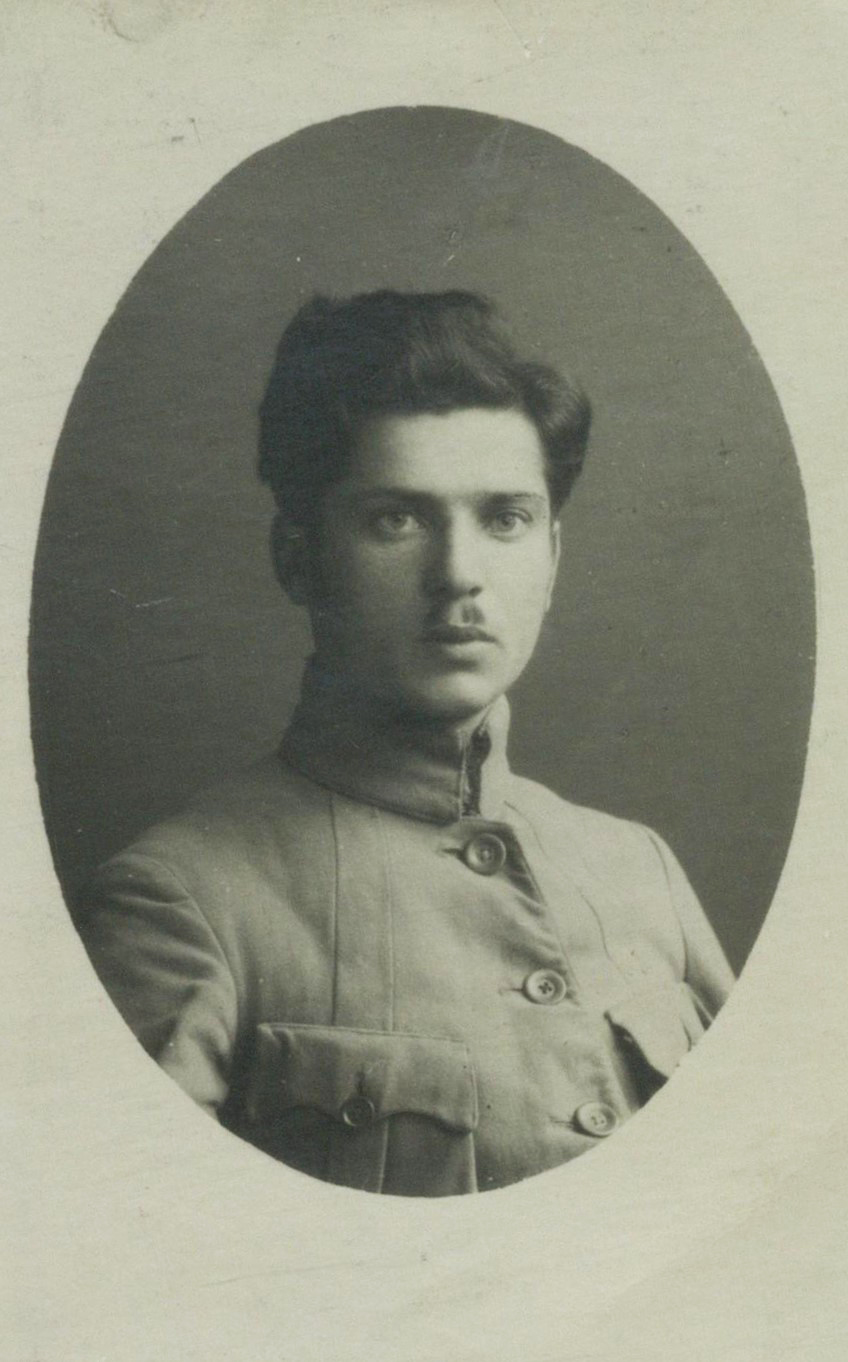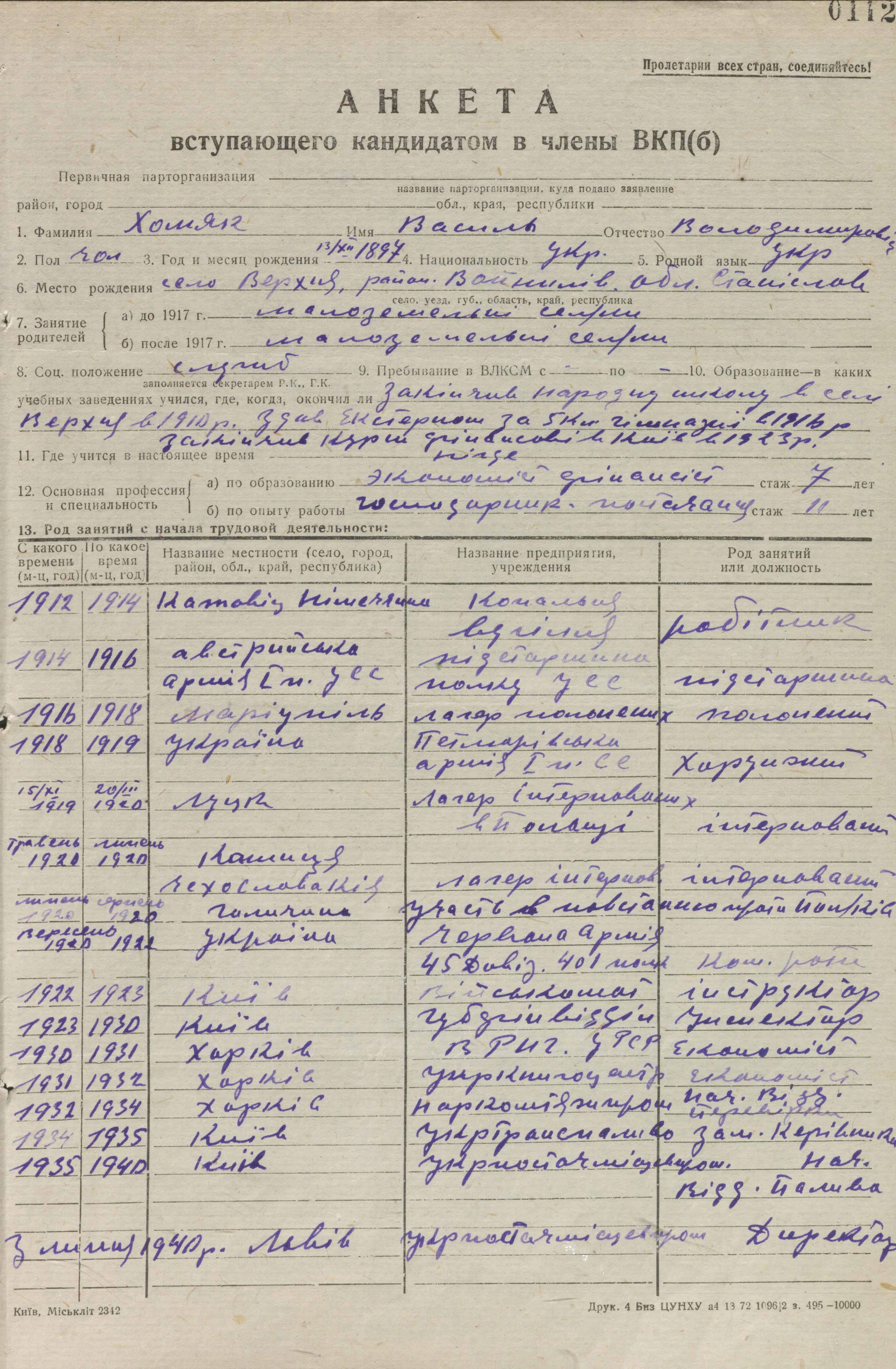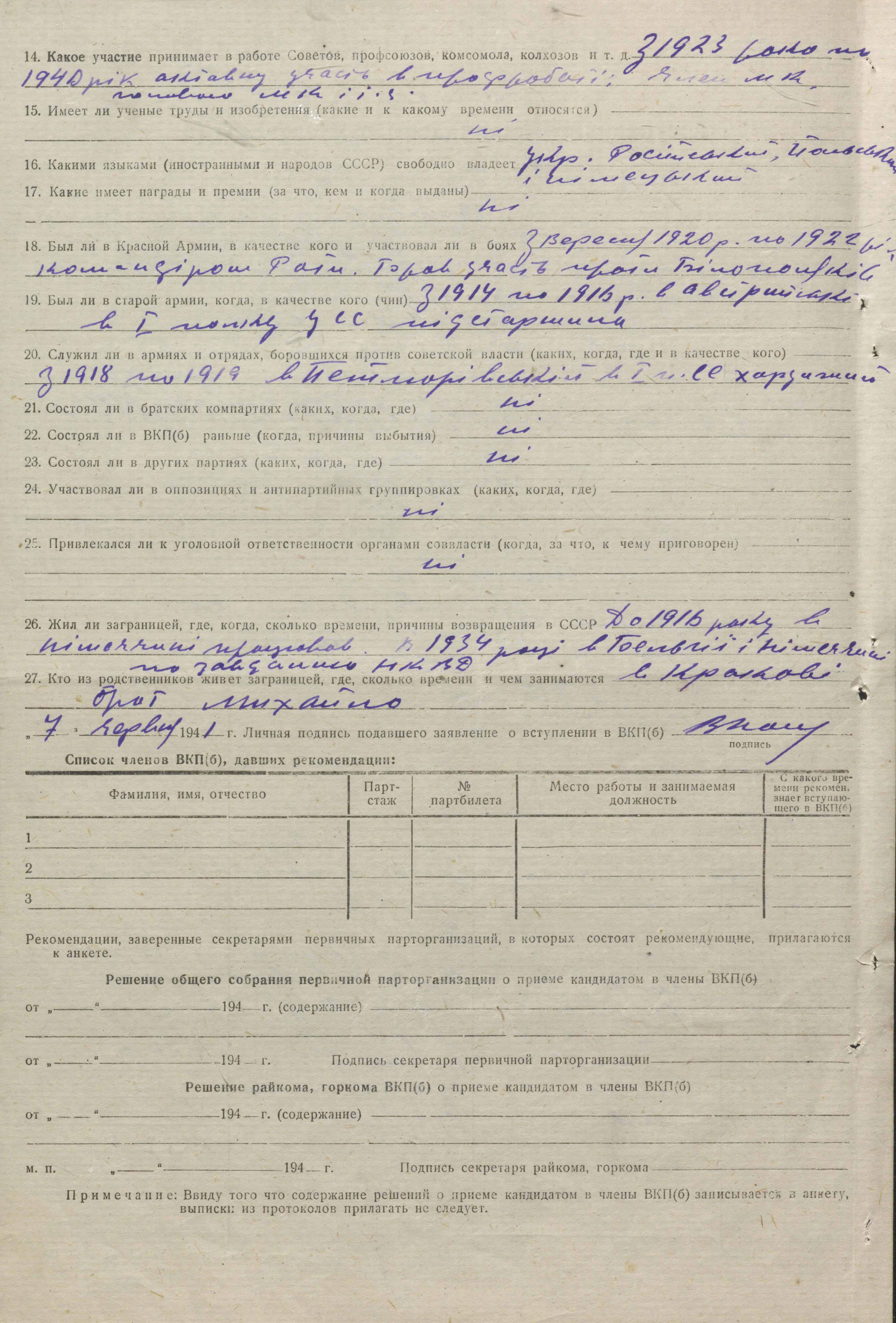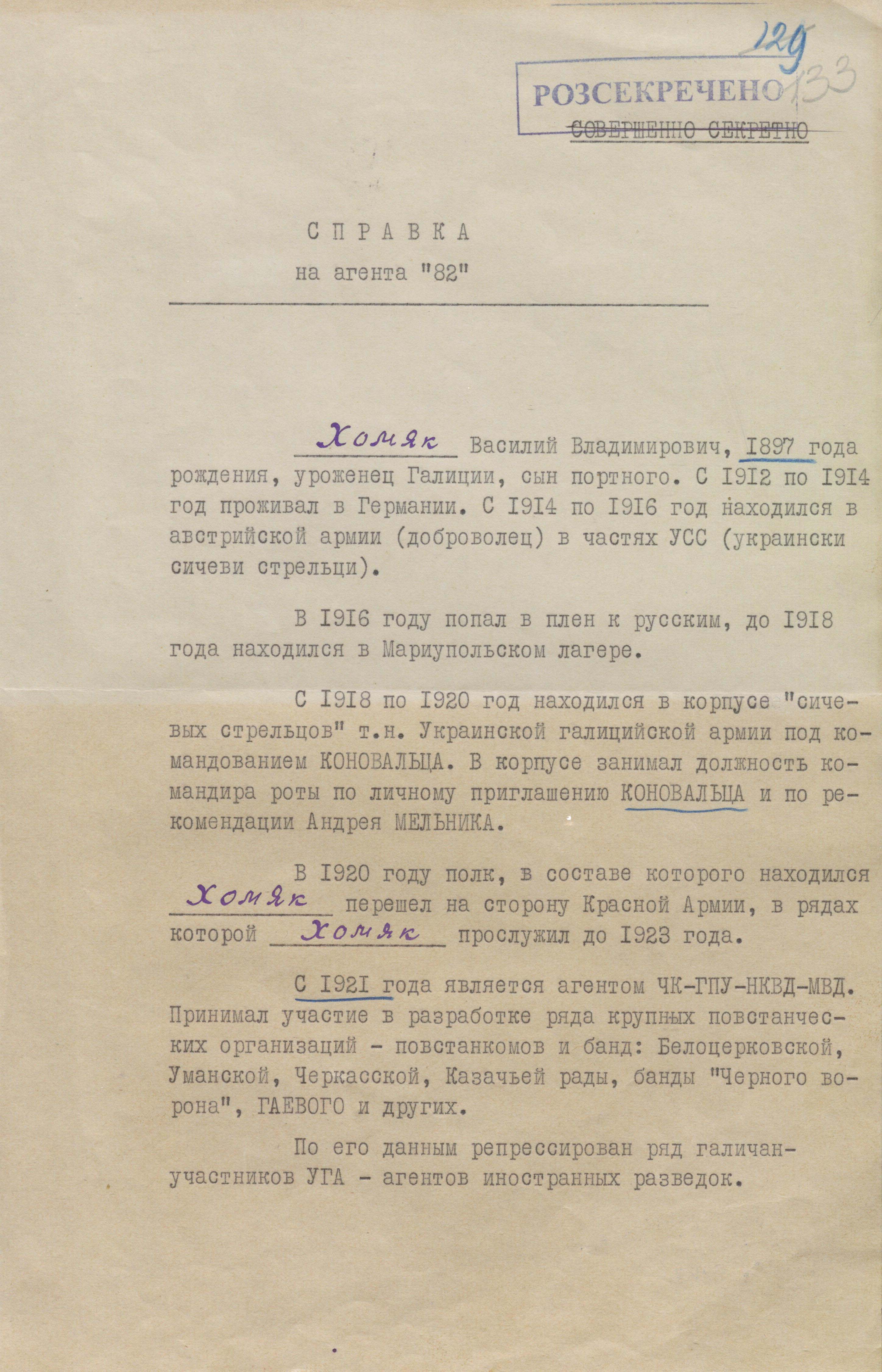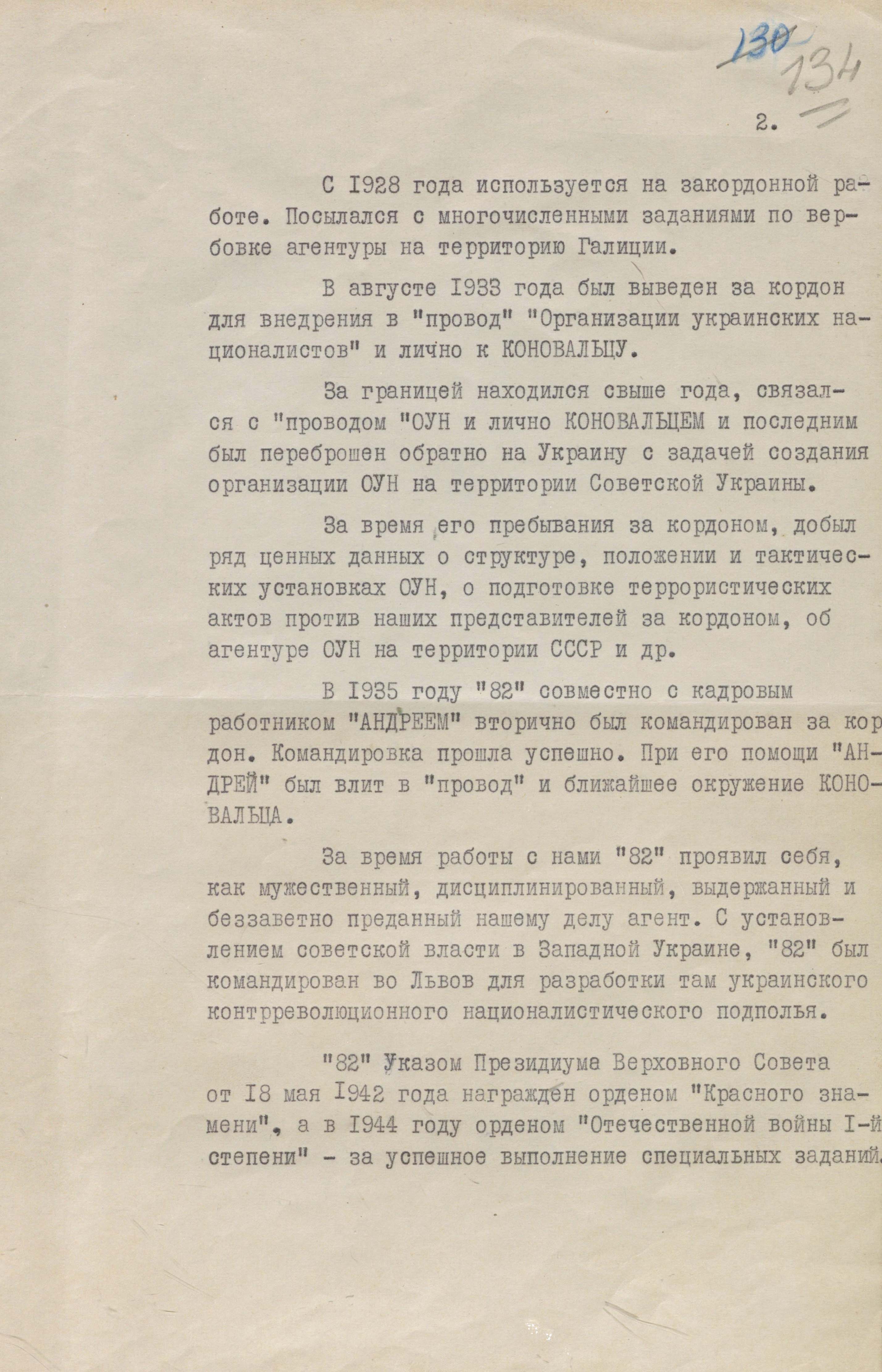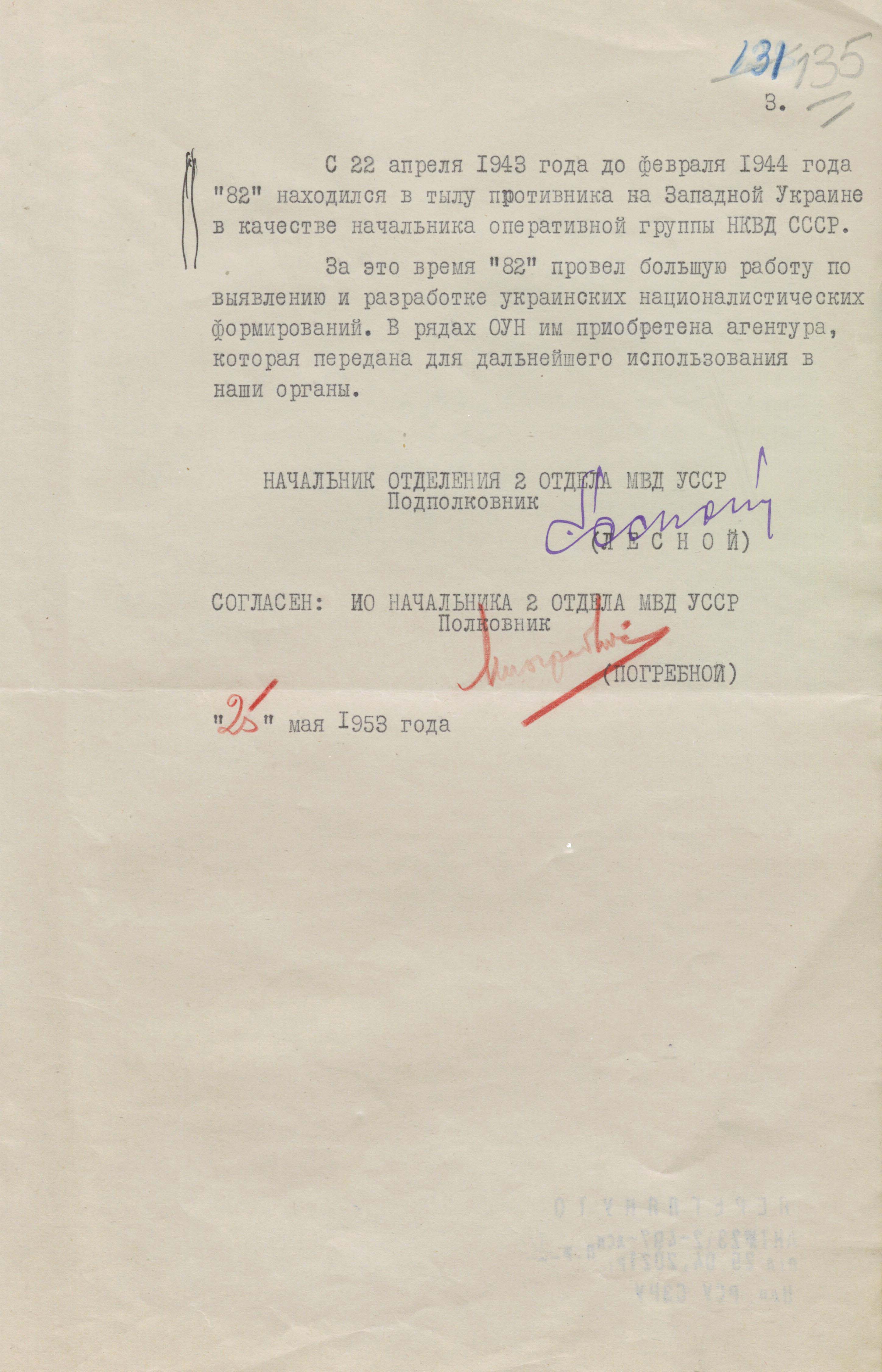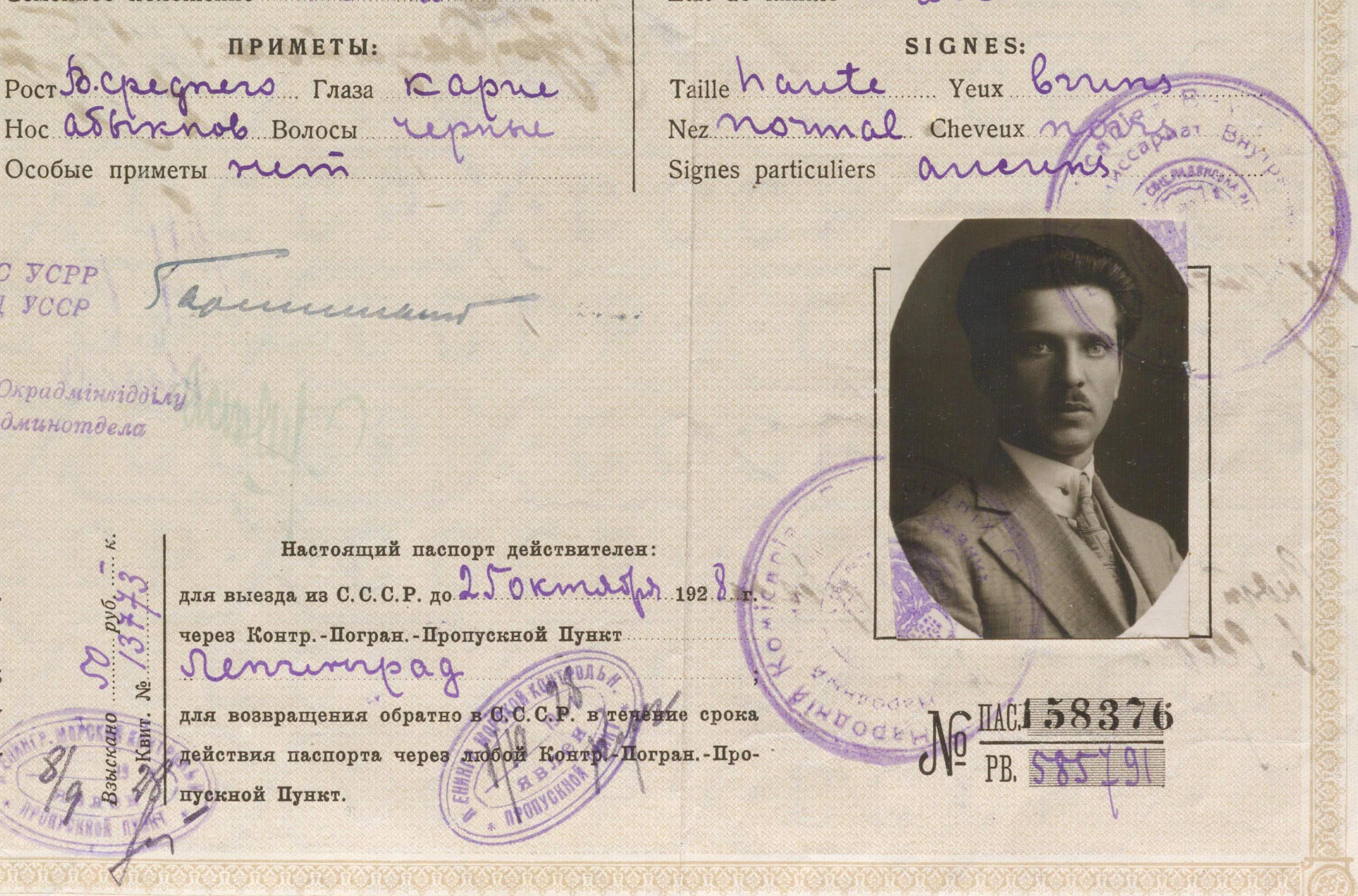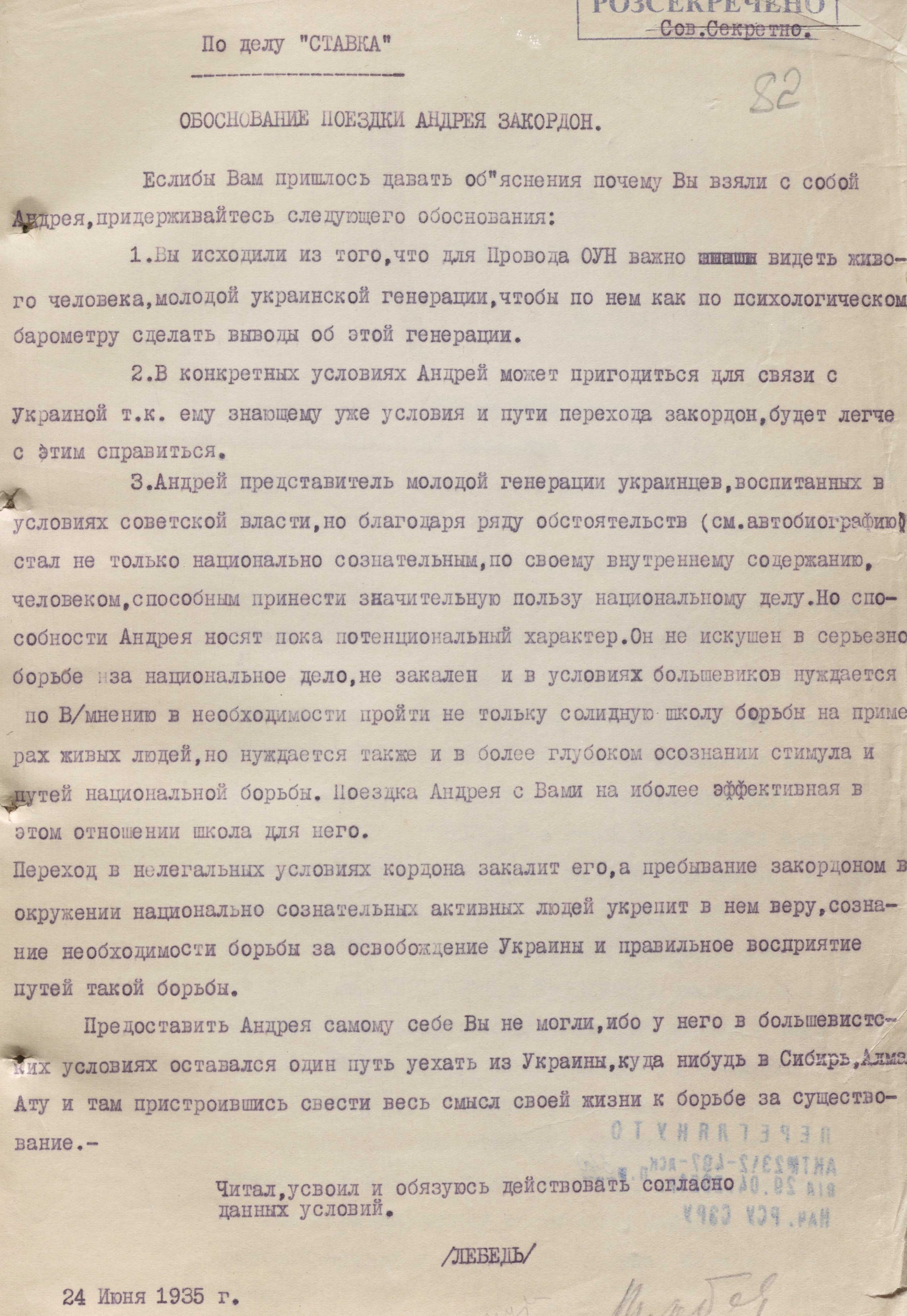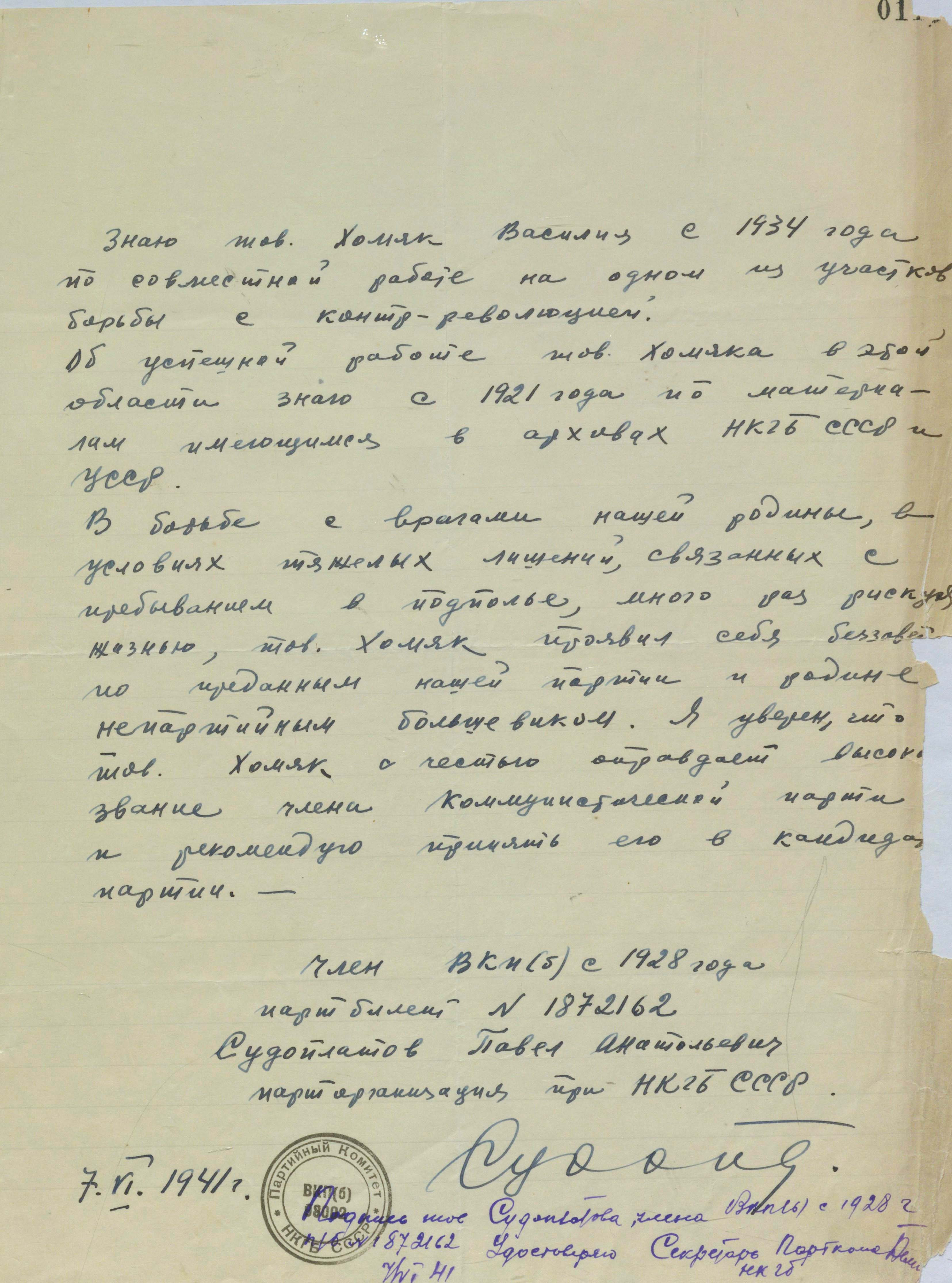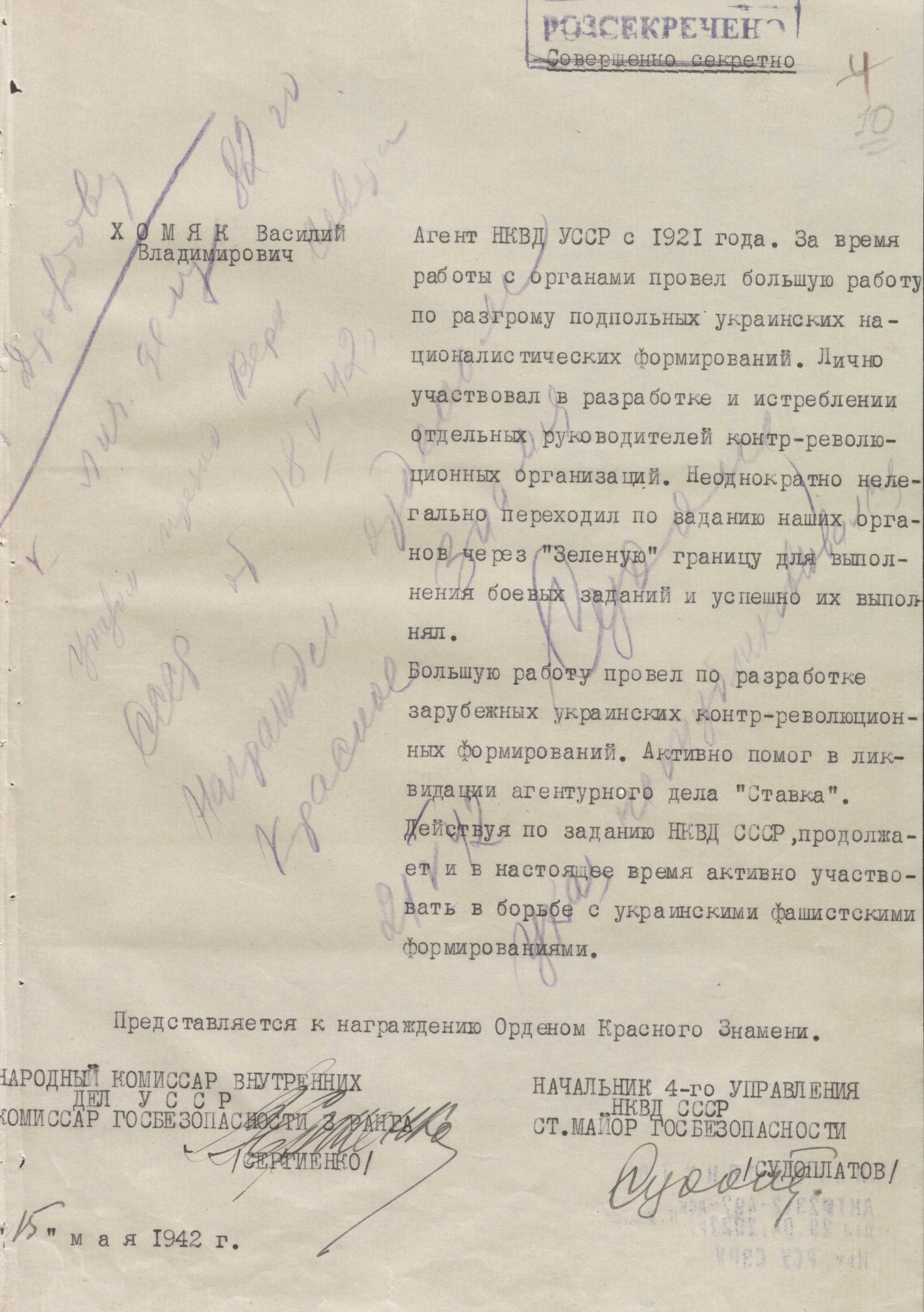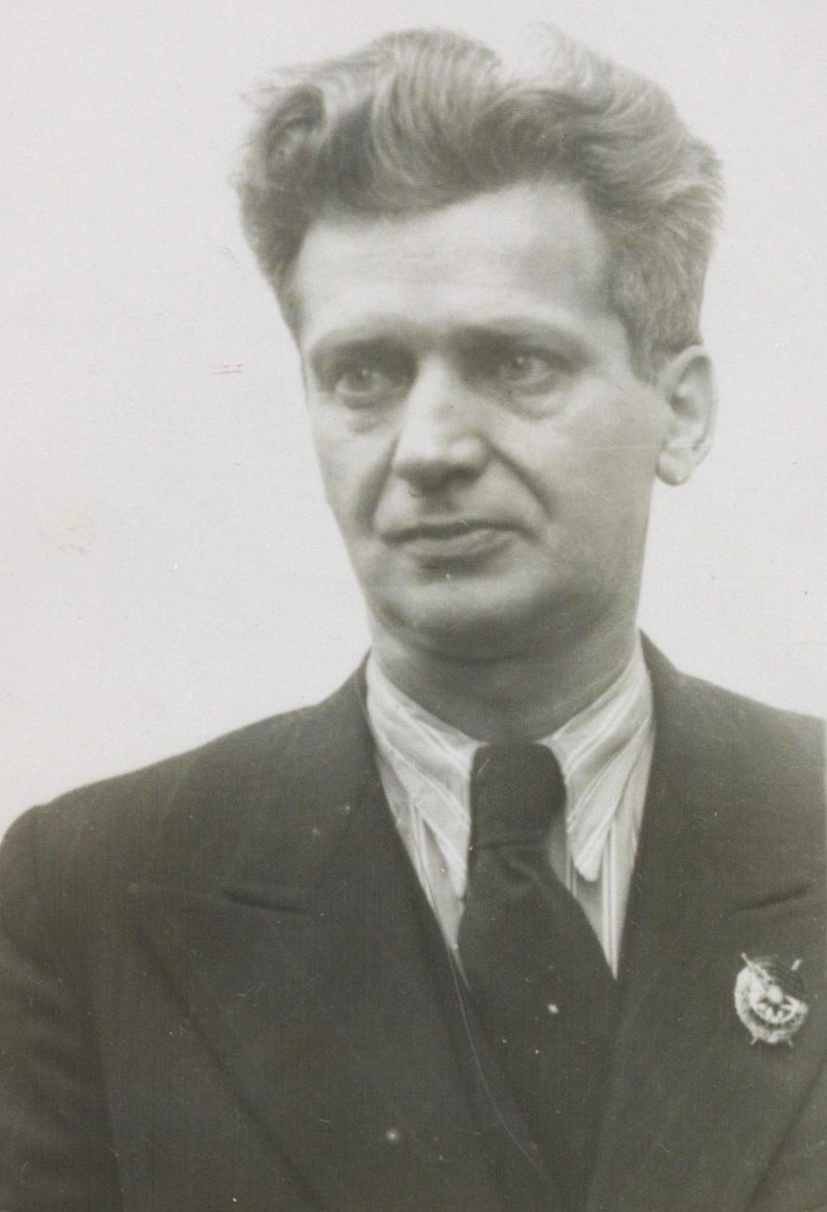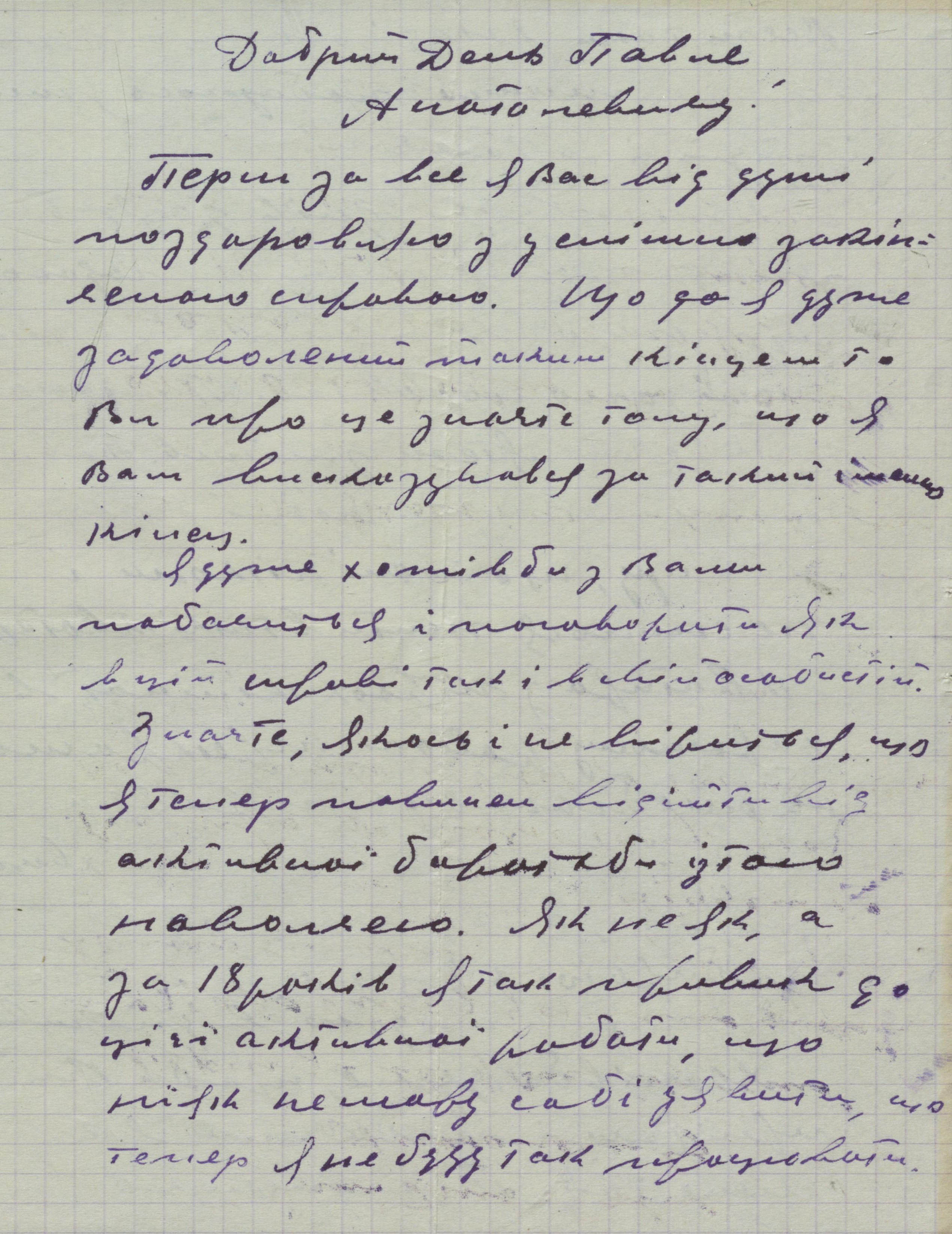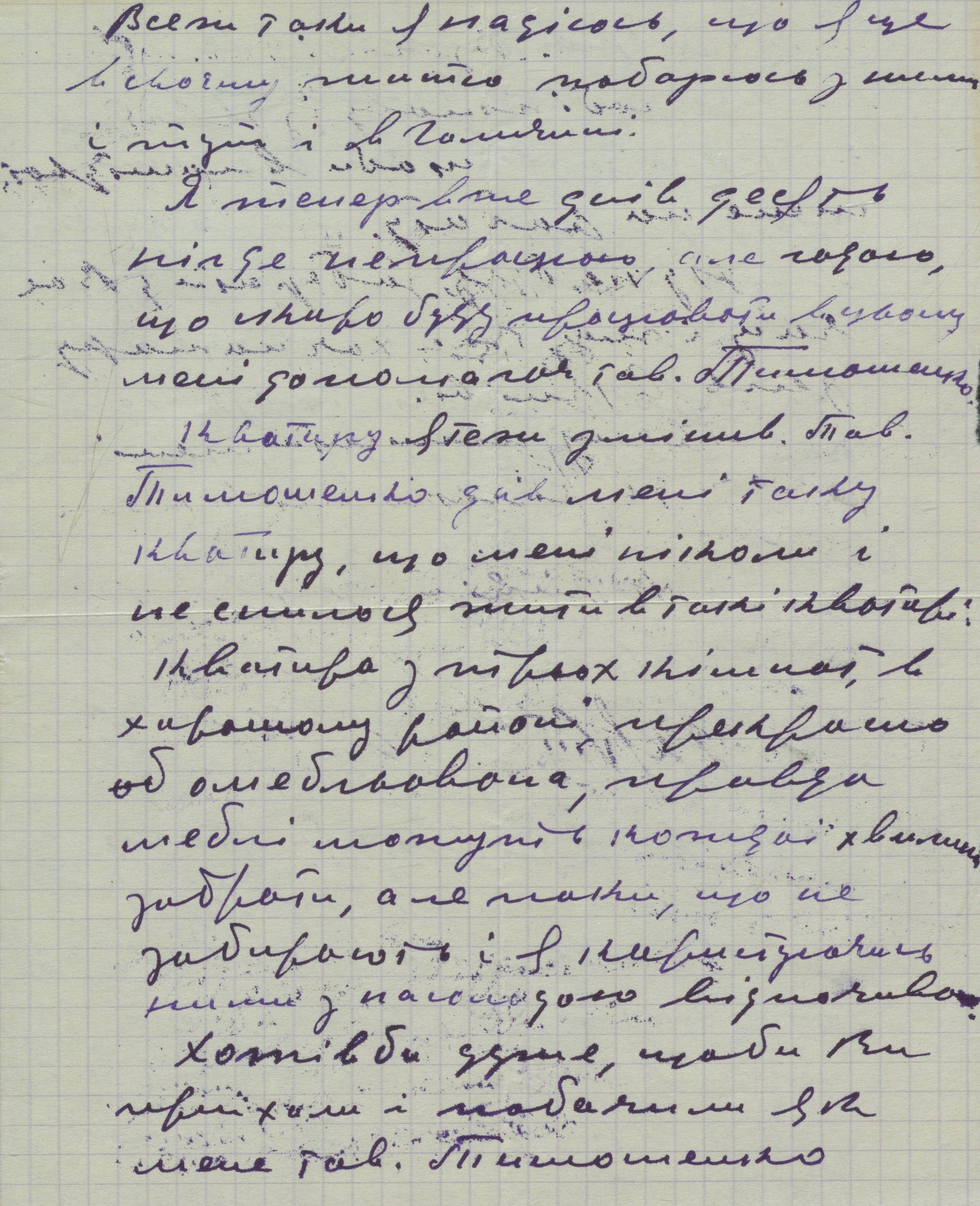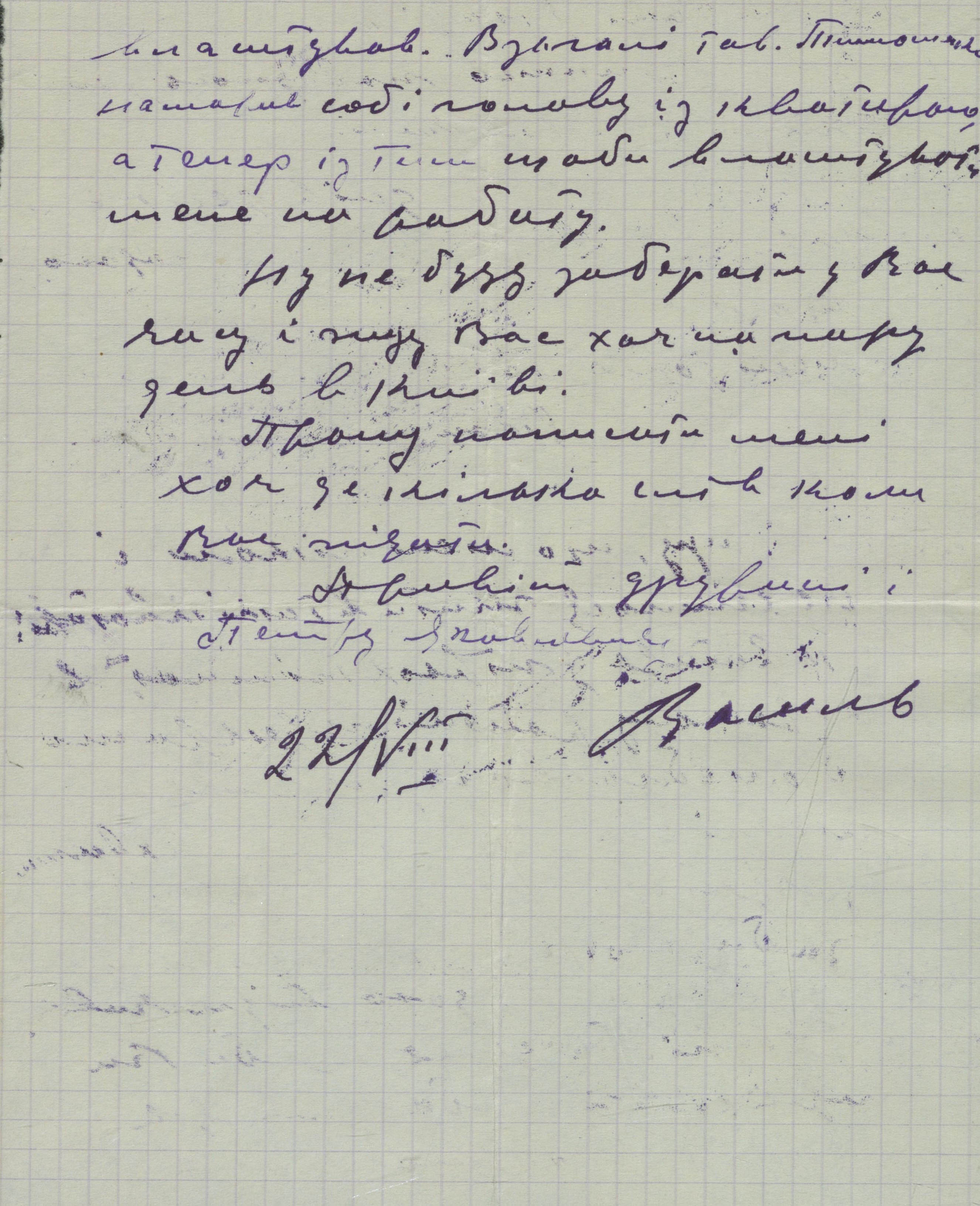For the Liquidation of Konovalets – A Three-Room Flat and 1,000 Rubles to Buy Furniture
5/23/2023
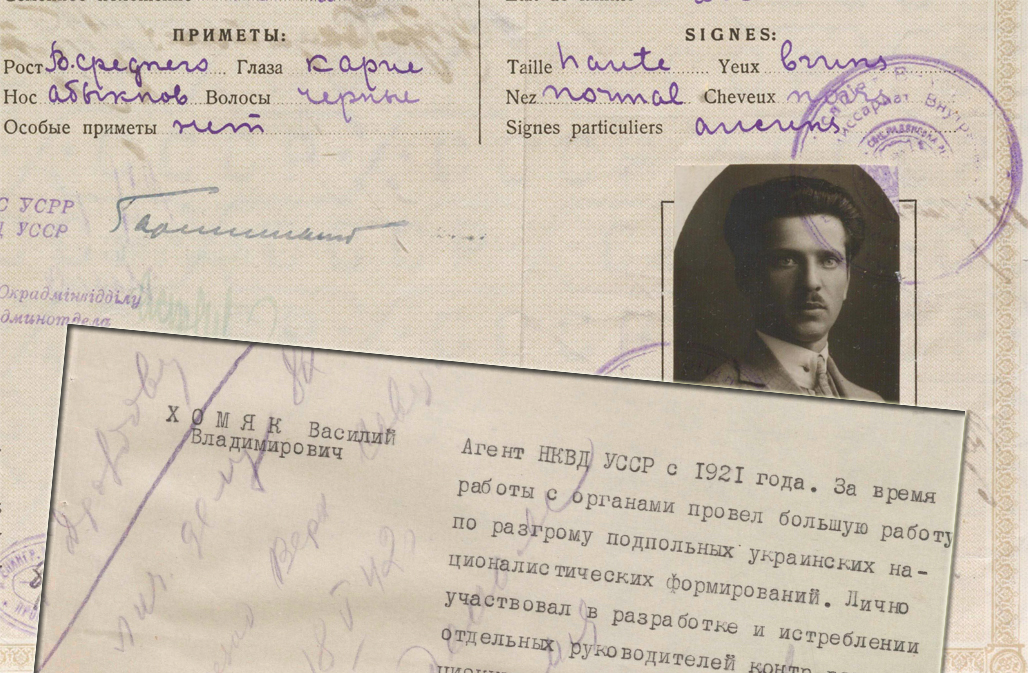
In the archival funds of the Intelligence there are materials that shed light on some details of a large-scale operation to liquidate leader of the OUN Provid Yevhen Konovalets, which was carried out on May 23, 1938 by Pavlo Sudoplatov on the direct orders of Joseph Stalin. New evidence of the Bolshevik regime’s crime against the Ukrainian liberation movement is based on written reports of one of the main defendants in the case, Vasyl Khomiak, an especially valuable agent of the GPU/NKVD of the Ukrainian SSR, who acted under the pseudonyms “Lebed” and “82” and who managed to infiltrate the killer into the close circle of the leader of the Ukrainian nationalists under the guise of his relative.
In the Ranks of the Ukrainian Sich Riflemen
The declassified case against Vasyl Khomiak in the Branch State Archives of the Foreign Intelligence Service of Ukraine makes it possible to clarify a number of issues regarding his biography, which until now has been interpreted differently in different sources. In particular, about his stay together with Yevhen Konovalets in the Russian prisoner of war camp near Tsaritsyn during 1916-1917, about commanding a division in the UPR Army, etc.
In his autobiography, written on June 7, 1941, for admission as a candidate for membership in the CPSU(b), Vasyl Volodymyrovych Khomiak reported the following information about himself. Born on December 13, 1897 in the village of Verkhnia, Voynyliv district, Stanislav (now Ivano-Frankivsk) region in a large family. There were 12 children in the family. The father worked as a village tailor. There was not enough money to educate all the children. That is why Vasyl graduated only from the local school and in 1912, together with his sister, went to work in Germany, where he got a job as a horseman in a coal mine. With the outbreak of World War I in 1914, he was sent to Austria, where at the age of 17 he joined the Ukrainian Sich Riflemen unit. He wrote about it as follows: “From an early age I was brought up in a nationalistic spirit at school and I joined the USR (Ukrainian Sich Riflemen)”.
At the front, V. Khomiak took part in hostilities, was a junior officer, was wounded and during treatment and vacation passed external exams for 5 grades of the gymnasium. “After my vacation, I was sent back to the front”, he said, “and in August 1916 I was captured by Russia and was in the camp for prisoners of war in Mariupol until 1918”. In the camp, in his words, he received a letter from Andriy Melnyk, in which he advised him to flee to Kyiv, where Yevhen Konovalets organized the USR corps at the Central Rada. Having escaped from the camp, in the autumn of 1918 V. Khomiak joined that formation, where “in the rank of khorunzhyi was a commander of a hundred until September 1919 and participated in battles against the Red Army” (BSA of the SZR of Ukraine. – F. 1. – Case 3. – V. 2. – P. 116-117).
Therefore, it is obvious that he was not with E. Konovalets in a prisoner of war camp in Tsaritsyn, was not his deputy in the corps of the USR and did not command a division at that time, as stated so far in various sources and studies in the absence of documentary evidence. The autobiography and the self-completed questionnaire of the candidate for membership of the CPSU(b) show otherwise.
The circumstances of V. Khomiak's getting acquainted with Ye. Konovalets are mentioned in one of his agent reports, which he then signed with the pseudonym “Lebed”. In it, he pointed out that he met E. Konovalets in Kyiv. “I got to know him closely”, he reported, “through the Chief of Staff of the Sich Riflemen Andriy Melnyk, with whom I had been closely acquainted since 1914 from the regiment of the Austrian Army, and I was his commander of the chota” (BSA of the SZR of Ukraine. – F. 1. – Case 6964. – P. 28).
In this report, V. Khomiak focused on the fact that Ye. Konovalets knew him in person and trusted him with responsible tasks. In particular, after the overthrow of the Hetmanate, he instructed him to negotiate with Otaman Zelenyi, who at that time opposed the Directory. On another occasion, in the autumn of 1919, he sent him at the head of a delegation to the Staff of a unit of the Red Army, which stood near Berdychiv and consisted mostly of Ukrainians and was led by a Ukrainian. He had the task to persuade the command of the unit to fight together against the Bolsheviks and Denikinists. He completed the mission successfully. As noted in the report, “1200 bayonets joined the UPR Army”.
After the defeat of the UPR Directory, V. Khomiak found himself in exile in Poland. About that period of his life, he wrote in his autobiography as follows:
“... The Sich Riflemen Regiment in which I served, was disarmed by the Poles and everyone was interned, me included, in a camp in Lutsk, and then I was transferred to Lviv. With the help of Konovalets and Melnyk, I left Lviv for Czechoslovakia.
In July 1920, Andriy Melnyk ordered me to come to Prague and told me to go to Galicia to the rebellion against the Poles under the nationalist flag. I went and took part in the uprising in Kalush region.
In September 1920, in connection with the persecution of me by the Poles, Konovalets and Sushko offered me to move to the Eastern Ukraine, but they gave me the task to carry out nationalist work there. I agreed and Sushko smuggled me across the border to the Soviet Ukraine. When I got to the Soviet Ukraine, I joined the Red Army (45th Division, 401st Regiment, where I was a company commander” (BSA of the SZR of Ukraine. - F. 1. – Case 3. - V. 2. - P. 116-117).
In his other reports, V. Khomiak explained that before leaving he had received instructions to rally Sich Riflemen devoted to the Ukrainian cause, to create underground centres and to be ready at a certain time to raise an uprising against the Bolshevik government, as well as, if possible, to join the ranks of the Red Army and carry out appropriate work there and wait for further instructions.
“Defector”
According to archival documents, at first V. Khomiak really acted according to the plan. In Volochysk, he was met by a detachment of Red cavalry and taken to a special department. After clarifying all the circumstances, he was sent to Vinnytsia at the disposal of the Main Kurin of the Reserve, which consisted mainly of Galicians and former Sich Riflemen. And since the Ukrainian Galician Army at that time united with the Red Army, there were no obstacles for enlisting him and appointing commander of a company or a hundred.
As stated by V. Khomiak, during the autumn of 1920 – winter of 1921, he and like-minded people tried to form underground fives, had contacts with the former sergeant of the Ukrainian Sich Riflemen Osyp Dumin, with Otaman of the UPR, Khorunzhyi- General of UPA Ivan Treyko. But after the defeat of the Second Winter Campaign led by Khorunzhyi- General of the UPR Army Yurko Tiutiunnyk and the break of the Red Ukrainian Galician Army with the Bolsheviks, the situation changed. At that time, the Chekists uncovered a number of insurgent committees, in particular in Kyiv and Uman, and arrests began.
“Then some of the former senior officers”, he pointed out in one of the messages, “left for abroad (Dolynskyi, Dumin), and almost all former senior officers, including me, from the Galician Regiment were arrested by the Kyiv Special Department. Six months later, we were released, but dismissed from the army. The reasons for the arrests, and the names of those who issued all this, cannot be precisely established” (BSA of the SZR of Ukraine. – F. 1. – Case 3. – V. 6. – P. 45).
No information was found in archival documents about the details of V. Khomiak's recruitment by the Chekists. It is only noted that he had been in the agent apparatus since 1921. At the same time, in the questionnaire, he wrote that he served in the Red Army from 1920 to 1922. That is, even before his dismissal from the army or while in prison, which is more likely, he was persuaded or forced to cooperate. In his autobiography, V. Khomiak wrote about this as follows:
“Soon I became convinced of the slander against the Soviet government and the Communist Party, which we were fed there, I saw what the working class under the leadership of the Communist Party of the Bolsheviks was fighting for and came to believe that Ukrainian nationalists and I are heading different ways.
In 1921 I contacted the organs of the Extraordinary Commission and on its instructions, and then, on the instructions of the NKVD, began to fight against the enemies of Soviet power” (BSA of the SZR of Ukraine. – F. 1. – Case 3. – V. 2. – P. 116-117).
First, during 1922-1923, he worked as an instructor at the military commissariat in Uman, then, until 1930, as a financial inspector in the provincial department in Kyiv, after that – as an economist in various organizations in Kharkiv, after which he again moved to Kyiv. Among the archival documents there is his agreement with the Kyiv District Department of the GPU, in which he, as a defector, undertook to appear for registration every month, every 15th, and had no right to leave or change his place of residence without the knowledge of the GPU. Therefore, the “defector” had official grounds and explanations to his relatives and acquaintances for contact with his curators - Chekists.
In the role of Pavlo Sudoplatov’s “Uncle”
At the first stage, the Chekists used V. Khomiak for the operational development of insurgent committees in Ukraine. One of the documents in this regard states: “He participated in the development of large insurgent organizations – insurgent committees and gangs: Bila Tserkva, Uman, Cherkasy, Cossack Council, “Black Raven”’s, Hayovyi’s and others’ gangs. According to him, a number of Galicians, members of the UGA, agents of foreign intelligences, were repressed. Since 1928 he had been used in the work abroad. In 1928 he was twice sent to Poland to contact agent “Starshyna”; for the third time in the same year he went to Danzig to recruit his own brother. The latter refused to get recruited” (BSA of the SZR of Ukraine. – F. 1. – Case 3. – V. 1. – P. 110-111).
Since V. Khomiak knew many leading figures of the Ukrainian liberation movement who remained abroad and continued to struggle for the restoration of Ukraine's independence, the Chekists were interested in any information about them. Therefore, he supplied them with characteristics of Andrii Melnyk, Yevhen Konovalets, Roman Sushko, Dmytro Andrievskyi, Mykhailo Matchak and others. But even more important was the latest information about their views and plans. And this could only be learned from direct communication.
So, in the depths of the GPU of the Ukrainian SSR, a plan had matured to infiltrate V. Khomiak into the OUN Leadership. In August 1933, he was employed as a sailor on a Soviet cargo ship, on board of which he soon arrived in Belgium. There he found a member of the OUN Provid Dmytro Andrievsky. He told, according to a well-established legend, about how he was engaged in underground work, about the difficult situation in Ukraine, famine, repressions, arrests of Galicians, the danger that he, as a former senior officer of the Sich Riflemen, could be arrested. Supposedly, this was the reason for the escape. Later he met with Yevhen Konovalets.
“He stayed abroad for more than a year”, reads the NKVD’s paper, “contacted the OUN “provid”' and Konovalets personally, and the latter sent him back to Ukraine with the task to create an OUN organization on the territory of Soviet Ukraine. During his stay abroad, he collected a lot of valuable intelligence on the structure, position and tactical provisions of the OUN, on the preparation of terrorist acts against our representatives abroad, on the OUN agents on the territory of the USSR, etc.” (BSA of the SZR of Ukraine. – F. 1. – Case 3. – V. 3. – P. 134).
In October 1934, the agent arrived in the USSR and reported to the GPU that he had fulfilled the task of gaining the trust of the OUN leadership. Later, in letters abroad, he reported on the creation of an underground network and the involvement of dedicated people in it. According to archival documents, V. Khomiak himself was the head of the “Ukrainian nationalist organization”. He corresponded with the OUN leadership under a certain code to fictitious addresses. He wrote his letters himself together with representatives of the NKVD “in compliance with the style of the Galician dialect”.
Soon a decision was made to infiltrate a staff member of the NKVD central apparatus into the cultivation of the OUN Leadership. Pavlo Sudoplatov, who was born in Melitopol, lived in Ukraine until 1933, worked in Kharkiv at the GPU of the Ukrainian SSR and spoke Ukrainian, was chosen for this role. In letters to Ye. Konovalets, V. Khomiak said that he had attracted his distant relative, whom he had known for a long time, brought him up in a nationalistic spirit and believed that this young man would make a useful fighter for the idea of independent Ukraine.
In his memoirs, P. Sudoplatov wrote that he acted as V. Khomiak’s nephew and a Komsomol member who was disappointed with the Soviet reality. It is not known whether he deliberately provided such somewhat distorted information, or whether he had already forgotten something by the time of writing his memoirs. The real detailed legend of “Andriy” (he received this operational pseudo) in archival documents is given as follows:
“1) I am a distant relative of “Lebid”’s' wife (first cousin).
2) Lately I worked as a teacher in Kharkiv – teaching the Ukrainian language.
3) Have not been a member of Komsomol.
4) Have never served in the Red Army – was enlisted in logistics as the son of a kulak.
5) Fled from the Soviet power’s persecution, having been accused of nationalist manifestations and teaching the Ukrainian language. As a result, was fired from work and banned from teaching altogether...” (BSA of the SZR of Ukraine. – F. 1. – Case 3. – V. 7. – P. 12).
To consolidate this legend, “Andriy”- Sudoplatov had a trip to Kharkiv. They manufactured and issued a passport in the name of Yatsenko Pavlo Anatoliyovych there. At the Passport Department they entered relevant information about his residence in V. Khomiak's flat. V. Khomiak showed him the house and his flat, as well as the seven-year school where “Andriy” allegedly worked.
In June 1935, Abram Slutskyi, the head of the Foreign Department of the GUGB NKVD USSR, had a four-hour conversation with V. Khomiak, and once again instructed him how to act abroad in order to be able to more easily enter Ye. Konovalets’ close circle. In order to consolidate relations and to educate the agent in the spirit of unquestioning love for the Soviet government and the Communist Party, A. Slutskyi instructed to give him a pass to the podium of Lenin's mausoleum for a sports parade. As noted in one of the documents, “Lebed” saw all the leaders and enjoyed the parade to bits.
The next day, the “fugitives” were sent to Petrozavodsk. They went to the border crossing point in the uniform of border guards so as not to attract excessive attention of local residents. Then they changed into civilian clothes. On the night of July 12, they crossed the Finnish border and in five hours covered 15 kilometers of marshy forest terrain. Later in his reports, V. Khomiak wrote that it was very difficult and asked to continue to choose easier ways to cross the border.
In Finland, at a meeting with representatives of the OUN leadership Dmytro Andriyevskyi and Omelyan Senyk, V. Khomiak, in accordance with his legend, described the “young nationalist” the best he could. To do this, he was recommended to say the following: “... It is important for the OUN Leadership to see a living person of the young Ukrainian generation in order to draw conclusions about this generation from him as a psychological barometer. In specific conditions, Andriy may be useful, because, as he is already familiar with the conditions and ways of crossing the border, it will be easier to cope with this... But Andriy's capabilities are still potential. He is not tempted in the seriousness of the struggle for the national cause, but hardened and under the Bolsheviks needs to go through not only a serious school of struggle on the examples of living people, but also to understand more deeply the incentives and ways of national struggle...” (BSA of the SZR of Ukraine. – F. 1. – Case 3. – V. 7. – P. 82).
Therefore, V. Khomiak was believed. Soon he was returned to the USSR, and his “pupil”, whom the OUN nicknamed Pryimak, and later – Pavlus, Velmud, Norman, Valyukh, remained abroad. Later he managed to get acquainted with Ye. Konovalets and establish a trusting relationship with him. They traveled together to Paris and Vienna, where they met with leaders of Ukrainian emigration, discussed plans for the deployment of the nationalist underground in Ukraine. Eventually the PUN instructed P. Sudoplatov to be a liaison with V. Khomiak and the “underground” organized by him in the Ukrainian SSR. To do this, he repeatedly crossed the Finnish-Soviet border and reported all the information received to the leadership of the NKVD of the USSR.
After the Kremlin got acquainted with the materials on Ye. Konovalets’ activities and plans, they decided to liquidate him. J. Stalin came up with the idea. While discussing possible ways of the operation, he pointed out that its main goal is to kill the leader of the OUN and force his environment to destroy each other in the struggle for power in the organization.
P. Sudoplatov without any hesitation began to prepare for this terrorist act. In May 1938, as a radio operator of a Soviet ship, he arrived abroad from the USSR and in a telephone conversation with Ye. Konovalets arranged a meeting in Rotterdam. At this meeting, he presented the head of the OUN with a box of chocolates in which an explosive device was mounted. The explosion occurred half an hour after P. Sudoplatov had left the restaurant.
Invitation for a House Warming Party
“Dear Pavlo Anatoliyovych,
First of all, I heartily congratulate you on a successfully completed business. That I am very pleased with such an end, you know about this because I told you exactly about such an end.
I would very much like to see you and talk to you both, about this matter and about my personal one...
I have not been working for ten days now, but I think that I will work soon, comrade Tymoshenko helps me with this (at that time Tymoshenko was the head of the 5th (Intelligence) Department of the First Directorate of the NKVD of the Ukrainian SSR – Author). I have also moved the flats. Comrade Tymoshenko gave me a flat I have never dreamed to live in. The flat of three rooms, in a good area, beautifully furnished, although the furniture can be taken away any minute, but so far it is not taken away, and I, using it, relax with pleasure. I would really like you to come and see how comrade Tymoshenko arranged everything for me...
22.VIII Vasyl”
(BSA of the SZR of Ukraine. – F. 1. – Case 3. – V. 3. – P. 136).
V. Khomiak wrote this letter to P. Sudoplatov shortly after the completion of the operation “Stavka”, as a result of which E. Konovalets was killed. According to the letter, the reward for participating in the operation was a three-room flat in Kyiv at 11, Shevchenko Boulevard. The family at that time consisted of three people – V. Khomiak himself, his wife and son.
The previous owner of the apartment in 1937 was arrested and sentenced to death with confiscation of all property for “treason” under Article 54-1, Point “A” of the Criminal Code of the Ukrainian SSR, and his wife, as a member of the convict's family, in June 1938 was deported to Kazakhstan for five years by decision of the Special Meeting of the NKVD of the USSR. The accomplice in the murder of Y. Konovalets began to enjoy everything that “the people’s enemies” had gained during their lives (fully justified in 1959 in the absence of corpus delicti). According to documents, the furniture included old Zeiss bookcases, a fireplace with a bronze clock on it, oak furniture in the kitchen, porcelain sets, silver cutlery, a Viennese rolling chair, a piano, tapestries, carpets, a gramophone and more.
Soon the question arose of transferring this property, which by a court decision was subject to confiscation into state revenue, at the disposal of the Economic Department of the NKVD of the Ukrainian SSR. To compensate for such “inconveniences”, the leadership of the 5th Department of the UGB of the NKVD of the Ukrainian SSR, which took care of V. Khomiak, addressed a report to the People's Commissar of Internal Affairs of the Ukrainian SSR Ivan Serov. It asked for consent to allocate to the agent other furniture from the funds of the Department or '... It is best to give “82” cash in the amount of 3,000 rubles, which, on the one hand, will be an incentive which he fully deserves, and on the other – will help him equip his home” (BSA of the SZR of Ukraine. – F. 1. – Case 3. – V. 1. – P. 286). On the report there is a resolution: “The People's Commissar has been reported. It is allowed to give him 1 thousand rubles”. Actually, this was V. Khomiak's fee for participation in the liquidation of Ye. Konovalets – a three-room apartment plus 1,000 rubles for additional furniture purchase.
At the same time, the NKVD took measures to encrypt the agent. To this end, his pseudonym was changed from “Lebed” to “82”.
According to the Plan Approved by Lavrentiy Beria
P. Sudoplatov, who “became a relative” of V. Lebed, never left him without his attention. Only the roles have changed. Now “Andriy” was the curator, and “Lebed” – “82”' was his ward. In one of the documents from Moscow to Kyiv, dated March 28, 1940, the deputy head of the 5th (Intelligence) Department of the GUGB NKVD USSR, Major of the State Security Service P. Sudoplatov pointed out that “82” as a person well aware of the specific features of the work of Ukrainian counterrevolutionary organizations, their personnel and methods of work can be useful in Western Ukraine as an illegal domestic resident in Ukrainian affairs.
The NKVD of the Ukrainian SSR agreed with this and arranged V. Khomiak’s transfer from Kyiv, where he at that time worked as the chief of the department at Ukprompostachmistsevprom, to Lviv to the post of deputy head of this branch. And later he became the director of it. In the new place he began to restore old ties. In this regard, he reported that he was well remembered for his active political activities in 1914-1920 and participation in the struggle for independent Ukraine.
Having received this information, P. Sudoplatov prepared a “Plan for the Operational Use of the Source “82” for the Cultivation of Personnel of the Ukrainian Nationalist Underground in Western Ukraine for the Nearest Future”, addressed to the People's Commissar of Internal Affairs of the USSR Lavrentiy Beria, which was approved in September 1940. This plan envisaged that “82” should occupy one of the central places in the underground and attract the most active nationalist elements to learn about their activities, and if necessary, influence these activities accordingly”.
V. Khomiak was supposed to become part of the leadership of the underground group. At the same time, he was assigned the role of the chief of the illegal residentura of the NKVD, which was supposed to consist of career Ukrainian Chekists and well-verified agents. “The main aim of the residentura”, says the plan, “should be: deep infiltration into the most active part of the Ukrainian underground – the OUN, capturing most important areas of activity of this militant anti-Soviet organization and leaving for abroad for the same purpose through the OUN channels” (BSA of the SZR of Ukraine. – F. 1. – Case 3. – V. 2. –P. 3-9).
Due to fears that representatives of the OUN could find out V. Khomiak's involvement in the murder of Ye. Konovalets, he was not sent abroad at that time. Meanwhile, they carried out appropriate checks and developed various operational measures to protect him in case of retaliation. They even gave him a gun by special order so that he could defend against a possible attack. At the same time, he was actively used in Western Ukraine to obtain information about the moods and plans of those who were dissatisfied with the actions of the Soviet government.
“In the struggle against the enemies of our Motherland”, P. Sudoplatov wrote about this activity in the recommendation for V. Khomiak’s joining the All-Union Communist Party(b), “in conditions of severe hardship, risking his life many times, comrade Khomiak has proved to be selflessly devoted to our party and homeland as a non-party Bolshevik” (BSA of the SZR of Ukraine. – F. 1. – Case 3. – V. 2. – P. 114).
V. Khomiak became a candidate to the CPSU(b) literally on the eve of the war. During his stay in the evacuation, he wrote letters to P. Sudoplatov, in which he expressed personal requests. The curator and patron did not ignore him. Already in the rank of the chief of the 4th Department of the NKVD of the USSR, he signed a submission to award the agent with the Order of the Red Banner, mentioning in the text all his “merits”, including participation in the operation “Stavka” to assessinate the leader of the OUN. The corresponding decree of the Presidium of the Supreme Soviet of the USSR was signed on May 18, 1942.
Soon, with P. Sudoplatov’s direct participation, V. Khomiak was appointed Commander of the special operational group of the NKVD of the USSR “Flag” and was given the pseudonym “Sokol” (“Falcon”- Transl.). The Group operated mainly in Rivne region. It is known from the few archival materials that he was in the rear from April 22, 1943 to February 1944 and that his activities were of a specific nature. One of the documents states the following: “During this time, “Sokol” has done a great job identifying and developing Ukrainian nationalist formations. The agents recruited by him in the ranks of the OUN were transferred for further use by the NKGB of the Ukrainian SSR” (BSA of the SZR of Ukraine. – F. 1. – Case 3. – V. 3. – P. 79). In a letter to P. Sudoplatov dated June 10, 1943, he wrote: “Tomorrow six men and I are going for 10 days to western regions near Rivne to obtain more detailed information about the armed groups of Banderites”(BSA of the SZR of Ukraine. – F. 1. – Case 3. – V. 3. – P. 57).
Other documents state that within six months he did not achieve significant results in agent cultivation. Despite this, he was awarded the medal “Partisan of the Patriotic War”, first class, and the Order of the Patriotic War, first class. As of May 1945, V. Khomiak was at the disposal of the NKGB of the Ukrainian SSR. And the paper for February 1950 states that “82” is included in the existing intelligence network and is in personal contact with the Deputy Minister of State Security of the Ukrainian SSR, Major-General Drozdov, and his case remains in the Office of the Directorate 2- N of the MGB of the Ukrainian SSR.
Directorate 2-N was the unit of the MGB entrusted with the task of fighting the resistance movement of the OUN and UPA, as well as foreign centers of Ukrainian nationalists. Therefore, even after the war, V. Khomiak continued to do what he had started since 1921. And his main place of work was the Ministry of Local Industry of the Ukrainian SSR, where in 1944-1946 he held the position of a member of the board – the chief of the Supply Department. In 1946, he was appointed the chief of the Supply Department of the United Nations Relief and Rehabilitation Administration (UNRRA) under the Council of Ministers of the Ukrainian SSR. In the affairs of this organization, he traveled abroad, in particular to the United States. After the liquidation of UNRRA, he began working as Deputy Head of the Board of Ukrpromrada (Ukrainian Council of Industrial Cooperation).
The last document in the case is dated February 24, 1954. It states that V. Khomiak, a member of the CPSU, works as the chief of the Main Department of Logistics of the Food Industry, “Ukrglavprodsnab”, Ministry of Food Industry of the Ukrainian SSR.
Information about V. Khomiak’s further work and participation in MGB operational activities was not found in archival documents. From other open sources it is known that in the postwar period he was involved in the development of operational measures through the Uniate Greek Catholic Church of Halychyna and the Greek Catholic Church. In this regard, he went on business trips to Moscow as part of a working group of employees of the Ministry of Internal Affairs of the Ukrainian SSR, which worked out a plan of appropriate measures. No evidence or even hints in letters, messages, reports could be found about changes in his views and attitudes to his actions in the past, even the slightest doubt or confession of guilt for having assisted in the assassination of his former military commander and fellow in arms Yevhen Konovalets.
